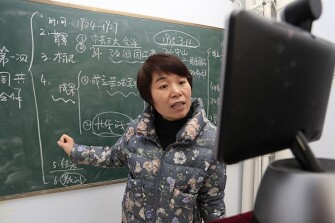
On the relatively rare occasions when disaster forces K-12 schools to close for a prolonged period of time, e-learning has helped fill the gap in instruction.
Asian countries affected by the SARS outbreak in 2003 turned to virtual instruction. When Hurricane Katrina battered New Orleans in 2005, Louisiana Virtual School expanded its capacity to meet students’ needs. Sixth-to-12th-grade students who lost their homes to Hurricane Sandy in 2012 kept learning thanks to New York state’s e-learning platform and donated e-learning program licenses from several companies.
The coronavirus outbreak this year has prompted similar action in China and Hong Kong, where schools are closed until at least next month amid concerns over a disease that has claimed more than 1,300 lives and affected more than 60,000 people worldwide. Several private companies have begun helping schools offer virtual instruction to students, and China’s Ministry of Education next week will begin uploading K-12 courses to a national online database.
Only 15 cases have been reported in the U.S., and officials are urging Americans not to panic. Hospitals are stockpiling resources in case the threat worsens. But the threat of school closures stateside inevitably looms.
Schools across the U.S. use virtual learning for more common occurrences like flu-related absences or inclement weather. Twelve states currently have explicit policies for “e-learning days,” which means they’re prepared to take students online in the event of a snow day or other emergency, according to a report from the Digital Learning Collaborative. Districts in several other states without formal policies have also experimented with taking students online when circumstances necessitate, according to the Collaborative report.
K12, Inc., one of the nation’s largest for-profit online education partners for K-12 schools, has developed protocols for dealing with a sudden surge of e-learning needs during previous incidents like flooding in Baton Rouge, La., and Houston, according to Karen Ghidotti, the company’s senior vice president of customer experience.
Schools offering online education to students in a situation like a coronavirus outbreak need to keep in mind that students might be unusually distressed, Ghidotti said. A “very solid and consistent learning” experience is essential so that students who might have a sick family member or otherwise fear catching the disease have a steady academic presence they can rely on.
Ghidotti’s team also urges school partners to keep parents and students clearly informed of the e-learning options: how to access them, how they work, what’s expected from them. On the company’s end, an emergency situation generally prompts contact with local officials and sometimes involves lifting existing caps on the number of students who can “enroll” in an online charter offering, she said.
Schools without built-in online protocols have options to quickly stand up e-learning too. Several schools in China and Hong Kong reached out in recent days to Century Tech, a U.K.-based technology company that offers a learning platform powered by artificial intelligence. The company’s customer success teams jumped into action to quickly onboard students and assign courses. “We can get schools up and running in about three hours,” said Charles Wood, the company’s head of international.
The Century Tech platform identifies topics students are struggling to grasp and offers them lessons accordingly. Teachers can track students’ progress and intervene when necessary.
Schools that designate a single project leader to serve as an intermediary between the company and parents and students have been most successful, according to Wood.
Wood also recommends that teachers set aside specific times to interact via virtual conference with parents and students to address misconceptions about the platform, and to suggest techniques students can use to break up their time in front of a screen.
“How many hours are you spending in front of a screen, reading a book, interacting with your siblings or parents?” Wood said. “It can come from the schools giving clear directions to parents. But it needs to come from the parents too, in a way that’s empowering the students to think about self-regulation.”
Image: Yuncheng, Shanxi, China: A teacher uses a multi-media network education system because of the novel coronavirus pneumonia. (Credit: © TPG via ZUMA Press)
